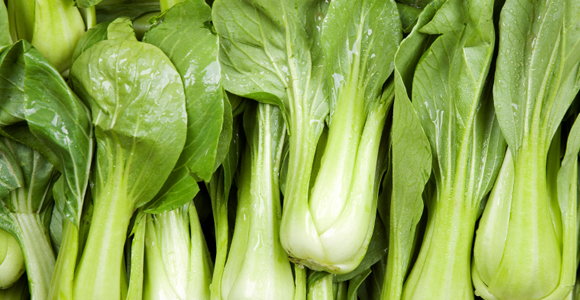Who knew that Chinese cabbage was so super? A recent study by Dr. Jennifer Di Noia of William Patterson University tested and categorized superfoods by their nutrient density. Foods that made the list had to have a measurable amount of potassium, fiber, protein, calcium, iron, thiamin, riboflavin, niacin, folate, zinc, and vitamins A, B6, B12, C, D, E and K in every 100-gram serving size. Chinese cabbage, which includes Napa cabbage and bok choy, came in at number two on the list.
Chinese cabbage is a member of the Brassica family and is related to other healthy vegetables like kale, broccoli and even Brussels sprouts. For every serving, this super-charged vegetable has only 16 calories and 91.99 percent of the daily value of vitamins and minerals listed above.
Aside from the amazing health benefits of Chinese cabbage, it also tastes delicious. From sauteing to steaming, in soups and in stews, this vegetable has a wonderfully crisp texture and a light celery-like flavor. One of my favorite ways to enjoy Chinese (Napa) cabbage is sauerkraut. Below is the recipe I use, and one that is easy to make at home.
Homemade Sauerkraut
Serves 6
This tasty recipe was originally created by Emma Christensen, recipe editor of The Kitchn, although I've made a few small modifications.You can visit her post here to read how she makes a delicious version of this recipe in a mason jar.
It was Chinese laborers who created the earliest version of sauerkraut by fermenting Chinese cabbage in rice wine. Germans later opted for the dry-cure method of salting the cabbage leaves to draw out their natural juices, which allowed it to ferment and be preserved. Fermentation is a powerful technique to create gut-healthy dishes that resist spoilage and incorporate the same good-for-you bacteria, lactobacillus, as in yogurt which helps regulate digestion. Enjoy this tangy, crunchy side dish on sandwiches, sausages or even as a snack on its own.
Ingredients
2 heads of Napa cabbage
1 ½ tablespoons sea salt
1 tablespoon caraway seeds (optional)
Directions
It is important to wash every ingredient, surface and utensil, including your hands exceptionally well. This will limit the chances that bad bacteria can grow during the fermenting process.
Cut the Napa cabbage in half lengthwise and rinse thoroughly.
Dry the cabbage well to remove any excess moisture.
Remove the core of each cabbage half, and then slice each section in half lengthwise.
Cross-cut the cabbage quarters into thin strips.
In a large mixing bowl add the sliced cabbage and sprinkle with salt.
Use your hands to mix the salt and cabbage together, squeezing as you go. This will help the salt penetrate the cabbage leaves and begin the fermentation process. The original recipe calls for caraway seeds for flavor, if you would like to season the sauerkraut, add 1 tablespoon of caraway seeds, or you can substitute them for the same amount of peppercorns, fennel seeds, or even fresh garlic. Get creative! Some people even use shredded beets and carrots in their sauerkraut.
After all the cabbage is massaged, it will be limp and wilted.
Make sure to press down on the cabbage to pack it down into the bowl. If any of the cabbage is not submerged in its own natural juices, it will not ferment properly, and can spoil.
Place a smaller, heavy-bottom bowl on the top of the sauerkraut to keep the cabbage pressed down. You'll need a piece of cheesecloth wide enough to cover the open surface of the bowls, and a ribbon or bungee cord to secure it. The cheesecloth will allow air to circulate (an important step in fermentation) while keeping dust and debris out of the sauerkraut.
Allow the cabbage to ferment for three to ten days. In that time you should see the liquid bubble and possibly foam. This just means the fermentation is working.
After three days, taste your sauerkraut, and if it tastes good, remove the smaller bowl, skim off any foam or scud that has developed, and seal in a suitable container with a tight-fitting lid.
You can continue to ferment the cabbage until you find the taste suits you.
Once it is in the refrigerator, it can keep for two months or longer.
Finding ways to incorporate Chinese cabbage into your diet won't be hard. There are many more recipes available online, like kimchi and stuffed cabbage that taste so delicious. I know once you give this superfood a try, you will also be singing its praises.
Bryanne Salazar is a freelance writer and editor, a contributing author for the website What the Flicka?, and a food-meets-culture blogger living in Southern California. Her blog, Bryanne Bites the World documents her explorations of various ethnic communities and food cultures across the United States. Bryanne has a degree in English focused on creative writing, and loves to pen short stories in her spare time. She is also an advocate for women and girls worldwide, the mother of two teenage boys, and the wife of an active duty United States Marine. You can follow Bryanne on Twitter and Facebook to see what she's working on next.



